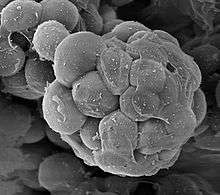Creolimax fragrantissima
Creolimax fragrantissima is a single-celled protist that occupies a key phylogenetic position to understand the origin of animals. It was isolated from the digestive tract of some marine invertebrates, mainly from the peanut worm, collected from the Northeast Pacific.
| Creolimax fragrantissima | |
|---|---|
 | |
| Scientific classification | |
| (unranked): | Choanozoa |
| Subphylum: | Choanofila |
| Class: | Ichthyosporea |
| Order: | Ichthyophonida |
| Genus: | Creolimax |
| Species: | C. fragrantissima |
| Binomial name | |
| Creolimax fragrantissima Marshall, 2008 | |
| Synonyms[1] | |
|
Ichthyophonida sp. fragrantissima | |
Taxonomy
Creolimax is a member of the Ichthyosporea, which is the earliest branching holozoan lineage.[2]
Applications
Creolimax is one of the few ichthyosporeans that is culturable. It can be easily grown in the lab through cycles of asexual reproduction. Each cycle comprises two stages. First, a growth stage, in which the cells, which are non-motile, contain several nuclei, a cell wall, and a big central vacuole. This stage is followed by a release of motile amoeboids, which are mono-nucleated and non-dividing.[3][4] Characterising those two stages can help to elucidate the development of specific cell types in multicellular animals.
Moreover, it has been shown that Creolimax uses a complex gene regulation system, including long non-coding RNAs and exon skipping alternative splicing, which were normally associated with multicellular animals.[4]
References
- "Creolimax fragrantissima". NCBI taxonomy. Bethesda, MD: National Center for Biotechnology Information. Retrieved 17 November 2017.
Other names: synonym: Ichthyophonida sp. fragrantissima Lineage( full ) cellular organisms; Eukaryota; Opisthokonta; Opisthokonta incertae sedis; Ichthyosporea; Ichthyophonida; Creolimax
- Torruella, G.; Derelle, R.; Paps, J.; Lang, B. F.; Roger, A. J.; Shalchian-Tabrizi, K.; Ruiz-Trillo, I. (2012-02-01). "Phylogenetic Relationships within the Opisthokonta Based on Phylogenomic Analyses of Conserved Single-Copy Protein Domains". Molecular Biology and Evolution. 29 (2): 531–544. doi:10.1093/molbev/msr185. ISSN 0737-4038. PMC 3350318. PMID 21771718.
- Marshall, Wyth L.; Celio, Gail; McLaughlin, David J.; Berbee, Mary L. (2008-07-01). "Multiple isolations of a culturable, motile Ichthyosporean (Mesomycetozoa, Opisthokonta), Creolimax fragrantissima n. gen., n. sp., from marine invertebrate digestive tracts". Protist. 159 (3): 415–433. doi:10.1016/j.protis.2008.03.003. ISSN 1434-4610. PMID 18539526.
- Mendoza, Alex de; Suga, Hiroshi; Permanyer, Jon; Irimia, Manuel; Ruiz-Trillo, Iñaki (2015-10-14). "Complex transcriptional regulation and independent evolution of fungal-like traits in a relative of animals". eLife. 4: e08904. doi:10.7554/eLife.08904. ISSN 2050-084X. PMC 4739763. PMID 26465111.